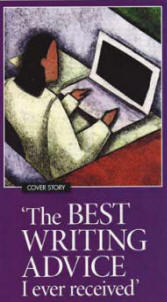|
Topics |
Novels of Migration and Travel |
Recommended Writers' Blogs
Writers' on Writing
 Johnson,
Sarah Anne. "The Best Writing Advice I Ever Received",
The Writer,
August 2010. Johnson,
Sarah Anne. "The Best Writing Advice I Ever Received",
The Writer,
August 2010.
Excerpt from Susan Vreeland:
In discussing a work in progress,
Julie Brickman, an instructor at Spalding University, spoke to me
about developing the 'interiority' of my main character. Interiority
was a new term for me, and I liked it. She defined it as the
conscious rendering of experience into understanding and insight,
and she cautioned me against thinking that a character's thought had
to be an abstraction or a result of intellect. Interiority could be
everyday things, what passes through the mind. They might be
recorded only as images. That opened up new possibilities of
showing a character trying to find his or her identity.
She spoke of mulling over
experience, and over other characters, examining himself or herself
in the process, and thereby undergoing a conscious
transformation. This released the fear I'd held about what to
narrate when there is little outward plot action.
more>>>
Susan Vreeland on
revision:
"Remove the narrative commentary on what you've
just written. It's just distrust of yourself. Let the details and actions speak
the conclusions. Play it off the money. Don't draw the conclusions for the
reader. Don't explain every nuance. The abstractions are just notes to
yourself."
Novels of
Migration and Travel
You can set a story anywhere. In
my experience, write-what-you-know straightjackets the imagination. Write what
you don't know; write what you dream about, what you long to know; write your
passion. We write for the same reason we read, to get new experiences, new
understandings, new ways to look at the world. If you're worried you don't know
enough, calibrate your protagonist to your level of knowledge; make her a
traveler; make him an outsider. What you know is emotional; it will come out in
any setting. And you might surprise yourself by what you know in a different
place.
Interiority:
Depth
Many writers believe that thought
is the equivalent of an abstraction and therefore to be avoided, but the ongoing
inner processes of a character include the everyday babble of appetites, images,
sensations, yearnings, and are what drives action in every scene. Interiors can
be written in the same vivid, sensory language as anything else; they use scene,
dialogue, color, realism, plot. One -third of Salman Rushdie's The Satanic
Verses is a dream sequence, but other than the frame, the dream has the same
drama as any other part of the plot. Show, don't tell, applies to the interiors
of your characters.
Exteriority:
Scope
Scope is all those things that
extend the range of a work of art. Generally, scope is made up of everything we
forget to include or think is boring: finances, work, politics, shopping,
philosophy, science. But made vivid, like Tolstoy (all of the above) in Anna
Karenina, Andrea Barrett (science) in Voyage of the Narwhal, Milan
Kundera (politics) in The Book of Laughter and Forgetting, Don DeLillo
(grocery shopping) in White Noise.
Recommended Writers' Blogs
Long
Pine Limited: Philip Deaver on the craft of fiction.
http://longpinelimited.blogspot.com
Spalding University's MFA in Writing Blog:
http://blog.spalding.edu/mfainwriting
Write
Some WhatNot: three writers musts about writing, teaching, and
whatnot. http://writesomewhatnot.com
Rhoda
Rabinowitz Green, Scribe:
http://rhodagreen.com/blog
A
Geezer's Journal:
http://geezerjournal.blogspot.com
Charlotte Rains Dixon:
http://www.wordstrumpet.com

|